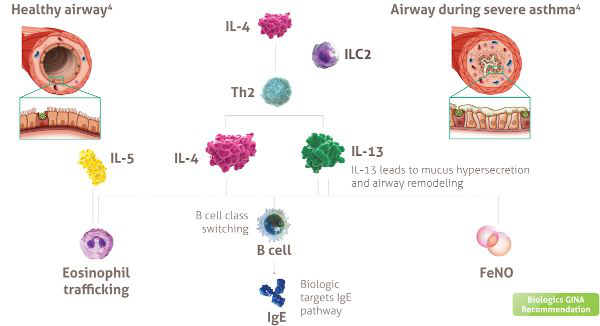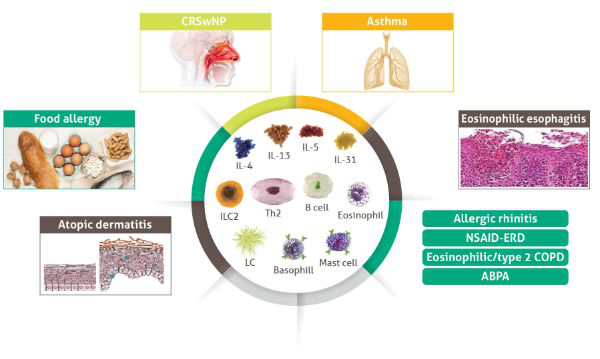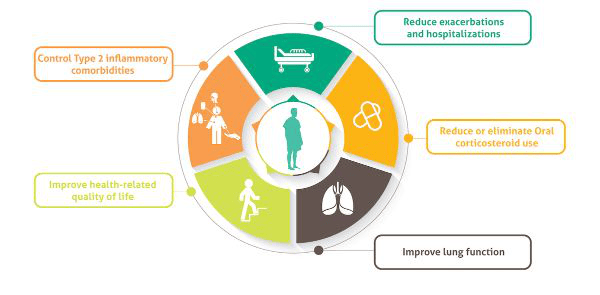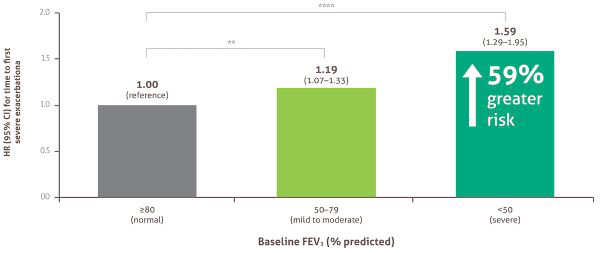About Type 2 Inflammation – Asthma
It’s time to address the full spectrum of Type 2 Inflammation in Asthma 50% to 70%a of adult patients with Asthma have Type 2 Inflammation¹
GINA Guidelines for difficult - to - treat and severe Asthma
Type 2 inflammation is indicated by elevated levels of one or more of the following markers²:
- Blood eosinophils ≥ 150 cells/µL
- Sputum eosinophils ≥ 2 %
- Sputum eosinophils ≥ 2 %
- Asthma is clinically allergen-driven IgE ≥ 20 IU/mL
- FeNO ≥ 20 ppb
Biomarkers of Type 2 inflammation may be suppressed by systemic corticosteroid use. This should be taken into consideration when determining Type 2 status in patients taking oral corticosteroids³
ᵃN=205.
ᵇN=37.
Abbreviations
GINA, Global Initiative for Asthma; ICS, inhaled corticosteroid; LABA, long-acting beta agonist.
- Peters MC, Mekonnen BA, Yuan S, et al. Measures of gene expression in sputum cells can identify TH2-high and TH2-low subtypes of asthma. J Allergy Clin Immunol. 2014;133(2):388–394.
- Global Initiative for Asthma. Difficult-to-treat & severe asthma in adolescent and adult patients, 2018. https://ginasthma.org/wp-content/uploads/2018/11/GINA-SAFINAL-wms.pdf. Accessed March 11, 2019.
- Dupixent Summary of Product Characteristics. October 2019.
Type 2 Inflammation
IL-4 and IL-13: Central Cytokines that mediate Type 2 Inflammation, including Allergic and Eosinophilic1,2,3
Type 2 inflammation plays an important role in uncontrolled asthma, contributing to increased exacerbations and decreased lung function ²
- Dupixent Summary of Product Characteristics. October 2019.
- Robinson D, Humbert M, Buhl R, et al. Revisiting type 2-high and type 2-low airway inflammation in asthma: current knowledge and therapeutic implications. Clin Exp Allergy. 2017;47(2):161-175.
- Hammad H, Lambrecht BN. Dendritic cells and epithelial cells: linking innate and adaptive immunity in asthma. Nat Rev Immunol. 2008;8(3):193-204.
- Gandhi NA, et al. Nat Rev Drug Discov. 2016;15:35–50; 2. Mauad T, et al. J Allergy Clin Immunol. 2007;120:997–1009.
Type 2 Inflammation CoMorbidities
Type 2 Inflammatory Diseases Share Common Inflammatory Cells and Mediators¹⁻³
ABPA, allergic bronchopulmonary aspergillosis; COPD, Chronic Obstructive Pulmonary Disease; CRSwNP, chronic rhinosinusitis with nasal polyps; InterILC2, group 2 innate lymphoid cell; LC, Langerhans cell; NSAID-ERD, nonsteroidal anti-inflammatory drug exacerbated respiratory disease; Th, T helper cell
- Gandhi NA, et al. Nat Rev Drug Discov. 2016;15:35–50;
- Carr S, et al. Allergy Asthma Clin Immunol. 2011;7(Suppl. 1):S8;
- Steinke JW, Wilson JM. J Asthma Allergy. 2016;9:37–43
Type 2 Asthma includes a range of phenotypes
Type 2 Asthma GINA phenotypes¹
- Tran TN, Zeiger RS, Peters SP, et al. Overlap of atopic, eosinophilic, and TH2-high asthma phenotypes in a general population with current asthma. Ann Allergy Asthma Immunol. 2016;116(1):37-42.
- Global Initiative for Asthma. Difficult-to-treat & severe asthma in adolescent and adult patients, 2018. https://ginasthma.org/wp-content/uploads/2018/11/GINA-SAFINAL-wms.pdf. Accessed March 11, 2019.
Real World Evidence on Pheno Types
Saudi Arabia Real World Evidence Data for Mixed Phenotype Refractory Asthma¹
From Local Saudi Arabia Data, Almost 78% of Severe Ashtma patients with elevated Serum IgE and eosinophilic count1
The 78% mixed phynotyping patients have been subcategorized as following1
Methods:
A retrospective cross-sectional real-life study was conducted on patients attending adult refractory asthma outpatient clinic between 2015 and 2018.1
Serum total IgE level and blood EOS count on matched dates with spirometry and Asthma Control Test (ACT) scores were collected.1
All data were obtained while patients were not on biological agents.1
Fig. 1. Serum IgE levels and eosinophils count subgroups of patients with refractory severe asthma.
- Hani MS. Lababidi et al, Refractory asthma phenotyping based on immunoglobulin E levels and eosinophilic counts: A real life study, Respiratory Medicine 158 (2019) 55–58.
Severe Asthma treatment goals
Patients with uncontrolled persistent Asthma have a high disease burden1-9
- Price D, et al. NPJ Prim Care Respir Med. 2014;24:14009;
- Sullivan PW, et al. J Asthma. 2014;51:769–778;
- Haselkorn T, et al. J Allergy Clin Immunol. 2009;124:895–902;
- O'Byrne PM, et al. Am J Respir Crit Care Med. 2009;179:19–24;
- Bilodeau L, et al. Rhinology. 2010;48:420–425;
- Dean BB, et al. J Asthma. 2009;46:861–866;
- Chen H, et al. Value Health. 2008;11:231–239;
- Sanz de Burgoa V, et al. J Investig Allergol Clin Immunol. 2016;26:256–262;
- Lomper K, et al. Pneumonol Alergol Pol. 2016;84:212–221
FEV1 Correlation with AAER
Low Fev1 is a significant predictor of future severe exacerbations
Patients aged ≥18 years with moderate-to-severe asthma over a 36-month follow-up period (n=1865)
**p<0.01; ****p<0.0001. aCox proportional hazard model analysis adjusted for age at index date, smoking status, BMI, gender, rhinitis, chronic sinusitis, nasal polyps, atopic dermatitis, diabetes, anaphylaxis, ischemic heart disease, heart failure, food allergy, anxiety, depression, and psoriasis. BMI, body mass index; CI, confidence interval; HR, hazard ratioKhan A, et al. Ann Allergy Asthma Immunol. 2018;121:S22–S62
- Dupixent Summary of Product Characteristics. October 2019.





.png)
